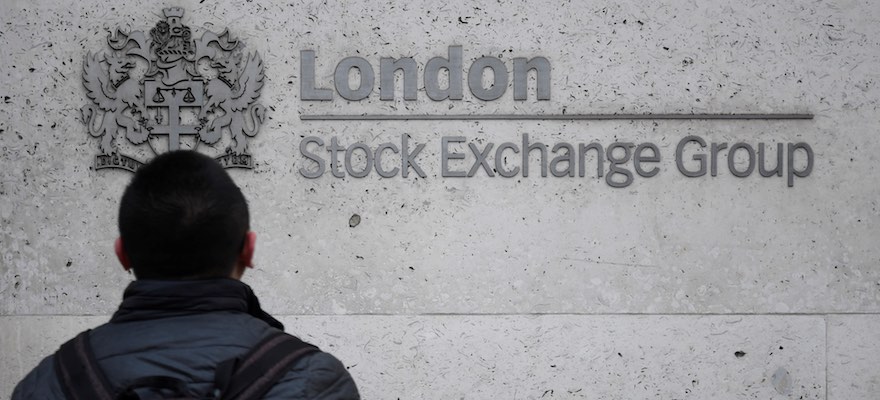The world’s biggest bond investors are leaving themselves with almost no room for error.
More than $2.5 trillion of euro-area government debt all but guarantee losses for buyers. Traders are ramping up wagers on a selloff in German bunds as 10-year yields approach April’s record lows. And jitters in the market are at levels last seen during the stunning rout in European debt markets a year ago.
Yet JPMorgan Asset Management, Standard Life Investments and Lombard Odier Asset Management all say there’s no reason to fear a violent reversal. Last time around, bond investors who pushed yields to such low levels suffered staggering losses as the European Central Bank’s quantitative easing spurred a glimmer of optimism in the region’s economy.
There’s little of that now. Despite negative interest rates and more than $650 billion in central-bank bond buying, the prospects for euro-area growth and inflation have only gotten worse. So whatever actions ECB officials decide to take at their meeting this week, many of those same investors are confident President Mario Draghi will have no choice but to press for even more aggressive measures in the weeks and months to come. And that will keep even negative-yielding bonds in demand.
“There’s always a risk of a selloff” like in 2015, said Jack Kelly, an Edinburgh-based money manager at Standard Life, which oversees about $360 billion. But, “we have a high conviction that the ECB will act. There needs to be a sense of urgency. Draghi fully understands the need to convince the market.”
Any selloff would be an opportunity to buy, Kelly said.
Getting it wrong could be disastrous, especially if last year’s experience is any guide. After average yields on euro-area sovereign debt fell to a record-low 0.425 percent a year ago, the most bullish bond buyers were run over.
Across the region, sovereign bonds lost more than 400 billion euros ($440 billion) in value during a two-month selloff that ended in June, data compiled by Bank of America Corp. show. Holders of longer-term German debt lost a record 13 percent in the second quarter alone, while bond markets in Asia and the U.S. were also upended by the fallout.
And because yields are so low, even mild disappointments can lead to big declines. After the ECB’s December meeting failed to inspire investors looking for bolder measures, euro government debt suffered the biggest single-day loss on record.
There isn’t a shortage of warning signs.
In the options market, the cost of bearish contracts on German bunds surged to the highest since October relative to bullish ones, data compiled by Bloomberg show. A measure of 30-day swings on bunds also jumped past the high in May, when the selloff sent 10-year yields soaring as high as 1.06 percent.
On Friday, they ended at 0.24 percent after falling to 0.102 percent earlier in the week. In April, yields reached a record-low 0.049 percent.
With negative-yielding bonds, “you are are really in prayer mode for the opportunity to sell to essentially a bigger fool,” said Zane Brown, a fixed-income strategist at Lord Abbett & Co., which oversees about $125 billion. “Markets have a way of hoping for more than what is deemed by policy makers to be prudent. And we see that phenomenon again and again.”
Brown says he prefers the U.S. to Europe. Benchmark U.S. Treasuries Yield
Yield
A yield is defined as the earnings generated by an investment or security over a particular time period. This is in typically displayed in percentage terms and is in the form of interest or dividends received from it.Yields do not include the price variations, which differentiates it from the total return. As such, a yield applies to various stated rates of return on stocks, fixed income instruments such as bonds, and other types of investment products.Yields can be calculated as a ratio or as a
A yield is defined as the earnings generated by an investment or security over a particular time period. This is in typically displayed in percentage terms and is in the form of interest or dividends received from it.Yields do not include the price variations, which differentiates it from the total return. As such, a yield applies to various stated rates of return on stocks, fixed income instruments such as bonds, and other types of investment products.Yields can be calculated as a ratio or as a
Read this Term 1.64 percentage points more than their German counterpart.
Yet, as more central banks experiment with negative-rate policies to revive their moribund economies, investors have become more willing to pay a fee to own sovereign debt. Just this month, Japan was paid to borrow almost $20 billion by selling 10-year bonds at negative yields for the first time.
And with benchmark Japanese yields at minus 0.04 percent, an increasing number of investors suggest German 10-year bunds can’t be far behind.
While figures last week suggested signs of life in euro-area employment, services and retail sales, ECB officials have thus far failed to spur any sort of meaningful improvement in the one number that really counts -- inflation.
Consumer prices in the 19-nation currency bloc fell in February at an annual rate of 0.2 percent -- the biggest setback in a year.
In the bond market, investors are pricing in inflation in Germany, Europe’s largest economy, of just 0.85 percent per year over the next decade. The ECB’s goal for the euro region is just under 2 percent. That’s upped the ante for ECB officials ahead of their two-day meeting starting March 9.
“There is a chance of a dovish shock” from the ECB, said Salman Ahmed, the chief strategist at Lombard Odier, which oversees about $150 billion. “German bunds should start to look very much like Japan in the coming months. We may see some Volatility
Volatility
In finance, volatility refers to the amount of change in the rate of a financial instrument, such as commodities, currencies, stocks, over a given time period. Essentially, volatility describes the nature of an instrument’s fluctuation; a highly volatile security equates to large fluctuations in price, and a low volatile security equates to timid fluctuations in price. Volatility is an important statistical indicator used by financial traders to assist them in developing trading systems. Traders
In finance, volatility refers to the amount of change in the rate of a financial instrument, such as commodities, currencies, stocks, over a given time period. Essentially, volatility describes the nature of an instrument’s fluctuation; a highly volatile security equates to large fluctuations in price, and a low volatile security equates to timid fluctuations in price. Volatility is an important statistical indicator used by financial traders to assist them in developing trading systems. Traders
Read this Term but the underlying gravity is toward lower interest rates.”
Ahmed expects the ECB, which has held its deposit rate below zero since mid-2014, to drop the rate even further. He also anticipates the central bank will start buying more bonds and extend the end date of its quantitative-easing program. The ECB’s current plan calls for purchasing 60 billion euros worth of bonds every month through March 2017.
Traders have already priced in a 0.1 percentage point cut in the deposit rate to minus 0.4 percent. Standard Life, Scotland’s second-biggest money manager, expects the ECB to increase its QE program about 15 billion euros a month.
Central-bank officials are doing little to discourage that view, with Executive Board Member Benoit Coeure saying on March 2 that ultra-low rates are justified by sluggish growth and inflation. A day earlier, Draghi said in a statement that ECB policy had to be seen against the background of increased risks to its own economic forecasts. The central bank will publish updated figures on March 10.
“We don’t see a bear market for government bonds,” said David Tan, the head of rates at JPMorgan Asset, which oversees more than $1.7 trillion globally. “This combination of low growth, low inflation and central bank accommodation with more to come will keep the environment very favorable.”
--With assistance from Liz Capo McCormick Eshe Nelson Anooja Debnath and Todd White To contact the reporter on this story: Lukanyo Mnyanda in Edinburgh at lmnyanda@bloomberg.net. To contact the editors responsible for this story: David Goodman at dgoodman28@bloomberg.net, Michael Tsang
By: Lukanyo Mnyanda
©2016 Bloomberg News
The world’s biggest bond investors are leaving themselves with almost no room for error.
More than $2.5 trillion of euro-area government debt all but guarantee losses for buyers. Traders are ramping up wagers on a selloff in German bunds as 10-year yields approach April’s record lows. And jitters in the market are at levels last seen during the stunning rout in European debt markets a year ago.
Yet JPMorgan Asset Management, Standard Life Investments and Lombard Odier Asset Management all say there’s no reason to fear a violent reversal. Last time around, bond investors who pushed yields to such low levels suffered staggering losses as the European Central Bank’s quantitative easing spurred a glimmer of optimism in the region’s economy.
There’s little of that now. Despite negative interest rates and more than $650 billion in central-bank bond buying, the prospects for euro-area growth and inflation have only gotten worse. So whatever actions ECB officials decide to take at their meeting this week, many of those same investors are confident President Mario Draghi will have no choice but to press for even more aggressive measures in the weeks and months to come. And that will keep even negative-yielding bonds in demand.
“There’s always a risk of a selloff” like in 2015, said Jack Kelly, an Edinburgh-based money manager at Standard Life, which oversees about $360 billion. But, “we have a high conviction that the ECB will act. There needs to be a sense of urgency. Draghi fully understands the need to convince the market.”
Any selloff would be an opportunity to buy, Kelly said.
Getting it wrong could be disastrous, especially if last year’s experience is any guide. After average yields on euro-area sovereign debt fell to a record-low 0.425 percent a year ago, the most bullish bond buyers were run over.
Across the region, sovereign bonds lost more than 400 billion euros ($440 billion) in value during a two-month selloff that ended in June, data compiled by Bank of America Corp. show. Holders of longer-term German debt lost a record 13 percent in the second quarter alone, while bond markets in Asia and the U.S. were also upended by the fallout.
And because yields are so low, even mild disappointments can lead to big declines. After the ECB’s December meeting failed to inspire investors looking for bolder measures, euro government debt suffered the biggest single-day loss on record.
There isn’t a shortage of warning signs.
In the options market, the cost of bearish contracts on German bunds surged to the highest since October relative to bullish ones, data compiled by Bloomberg show. A measure of 30-day swings on bunds also jumped past the high in May, when the selloff sent 10-year yields soaring as high as 1.06 percent.
On Friday, they ended at 0.24 percent after falling to 0.102 percent earlier in the week. In April, yields reached a record-low 0.049 percent.
With negative-yielding bonds, “you are are really in prayer mode for the opportunity to sell to essentially a bigger fool,” said Zane Brown, a fixed-income strategist at Lord Abbett & Co., which oversees about $125 billion. “Markets have a way of hoping for more than what is deemed by policy makers to be prudent. And we see that phenomenon again and again.”
Brown says he prefers the U.S. to Europe. Benchmark U.S. Treasuries Yield
Yield
A yield is defined as the earnings generated by an investment or security over a particular time period. This is in typically displayed in percentage terms and is in the form of interest or dividends received from it.Yields do not include the price variations, which differentiates it from the total return. As such, a yield applies to various stated rates of return on stocks, fixed income instruments such as bonds, and other types of investment products.Yields can be calculated as a ratio or as a
A yield is defined as the earnings generated by an investment or security over a particular time period. This is in typically displayed in percentage terms and is in the form of interest or dividends received from it.Yields do not include the price variations, which differentiates it from the total return. As such, a yield applies to various stated rates of return on stocks, fixed income instruments such as bonds, and other types of investment products.Yields can be calculated as a ratio or as a
Read this Term 1.64 percentage points more than their German counterpart.
Yet, as more central banks experiment with negative-rate policies to revive their moribund economies, investors have become more willing to pay a fee to own sovereign debt. Just this month, Japan was paid to borrow almost $20 billion by selling 10-year bonds at negative yields for the first time.
And with benchmark Japanese yields at minus 0.04 percent, an increasing number of investors suggest German 10-year bunds can’t be far behind.
While figures last week suggested signs of life in euro-area employment, services and retail sales, ECB officials have thus far failed to spur any sort of meaningful improvement in the one number that really counts -- inflation.
Consumer prices in the 19-nation currency bloc fell in February at an annual rate of 0.2 percent -- the biggest setback in a year.
In the bond market, investors are pricing in inflation in Germany, Europe’s largest economy, of just 0.85 percent per year over the next decade. The ECB’s goal for the euro region is just under 2 percent. That’s upped the ante for ECB officials ahead of their two-day meeting starting March 9.
“There is a chance of a dovish shock” from the ECB, said Salman Ahmed, the chief strategist at Lombard Odier, which oversees about $150 billion. “German bunds should start to look very much like Japan in the coming months. We may see some Volatility
Volatility
In finance, volatility refers to the amount of change in the rate of a financial instrument, such as commodities, currencies, stocks, over a given time period. Essentially, volatility describes the nature of an instrument’s fluctuation; a highly volatile security equates to large fluctuations in price, and a low volatile security equates to timid fluctuations in price. Volatility is an important statistical indicator used by financial traders to assist them in developing trading systems. Traders
In finance, volatility refers to the amount of change in the rate of a financial instrument, such as commodities, currencies, stocks, over a given time period. Essentially, volatility describes the nature of an instrument’s fluctuation; a highly volatile security equates to large fluctuations in price, and a low volatile security equates to timid fluctuations in price. Volatility is an important statistical indicator used by financial traders to assist them in developing trading systems. Traders
Read this Term but the underlying gravity is toward lower interest rates.”
Ahmed expects the ECB, which has held its deposit rate below zero since mid-2014, to drop the rate even further. He also anticipates the central bank will start buying more bonds and extend the end date of its quantitative-easing program. The ECB’s current plan calls for purchasing 60 billion euros worth of bonds every month through March 2017.
Traders have already priced in a 0.1 percentage point cut in the deposit rate to minus 0.4 percent. Standard Life, Scotland’s second-biggest money manager, expects the ECB to increase its QE program about 15 billion euros a month.
Central-bank officials are doing little to discourage that view, with Executive Board Member Benoit Coeure saying on March 2 that ultra-low rates are justified by sluggish growth and inflation. A day earlier, Draghi said in a statement that ECB policy had to be seen against the background of increased risks to its own economic forecasts. The central bank will publish updated figures on March 10.
“We don’t see a bear market for government bonds,” said David Tan, the head of rates at JPMorgan Asset, which oversees more than $1.7 trillion globally. “This combination of low growth, low inflation and central bank accommodation with more to come will keep the environment very favorable.”
--With assistance from Liz Capo McCormick Eshe Nelson Anooja Debnath and Todd White To contact the reporter on this story: Lukanyo Mnyanda in Edinburgh at lmnyanda@bloomberg.net. To contact the editors responsible for this story: David Goodman at dgoodman28@bloomberg.net, Michael Tsang
By: Lukanyo Mnyanda
©2016 Bloomberg News















